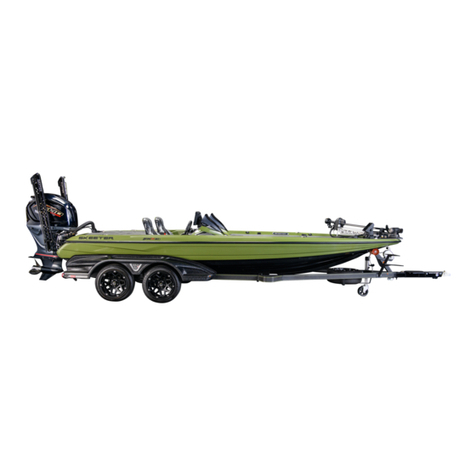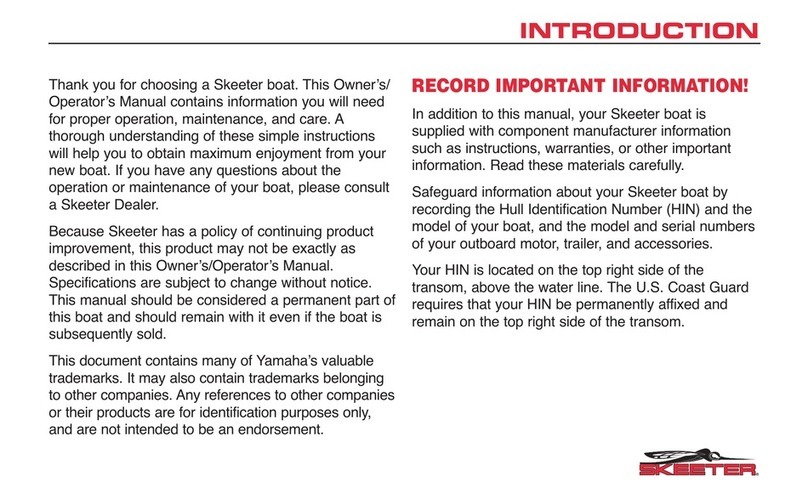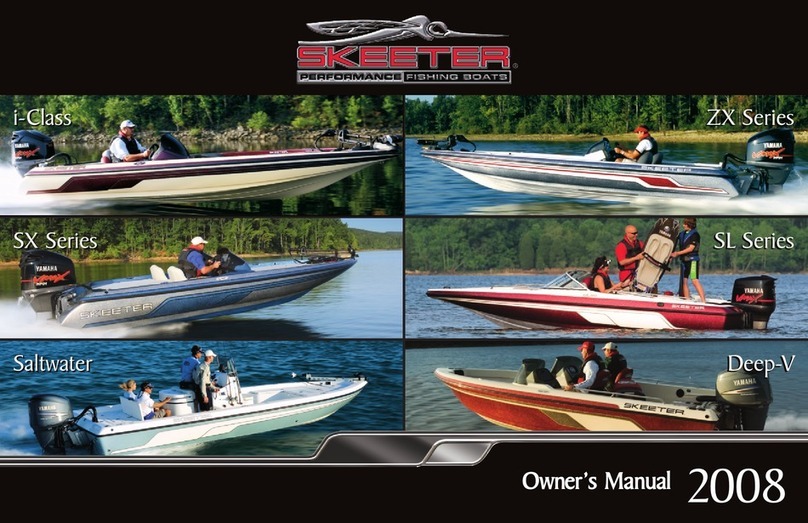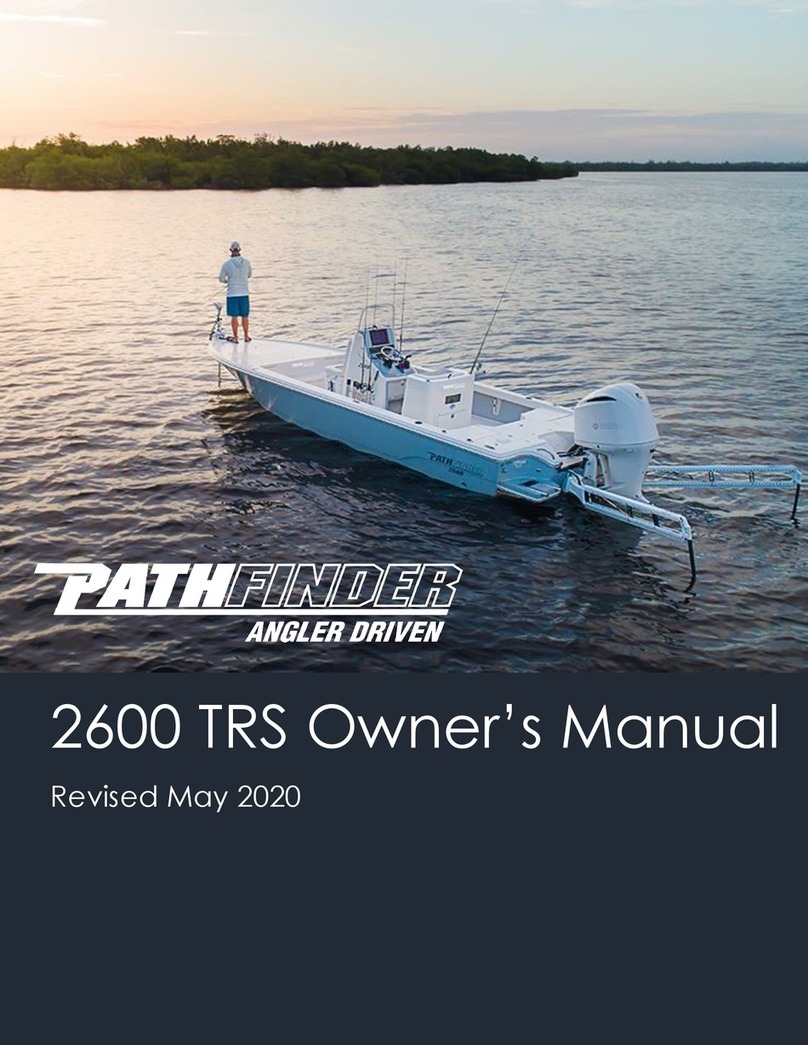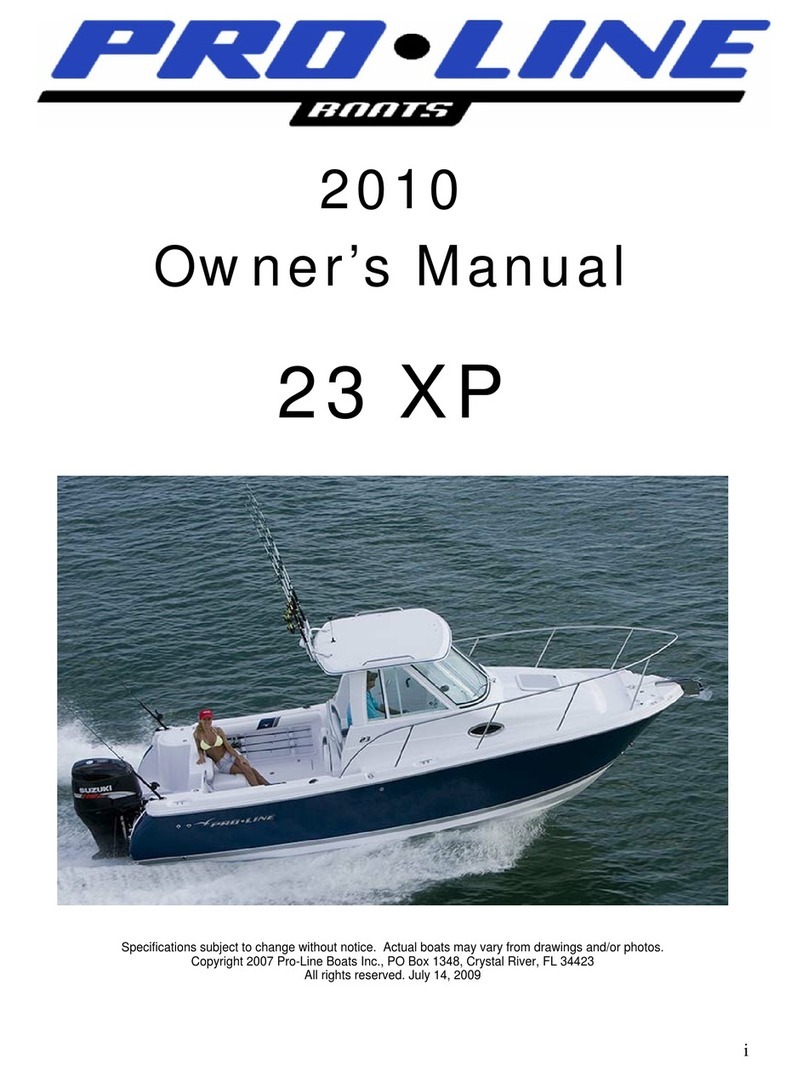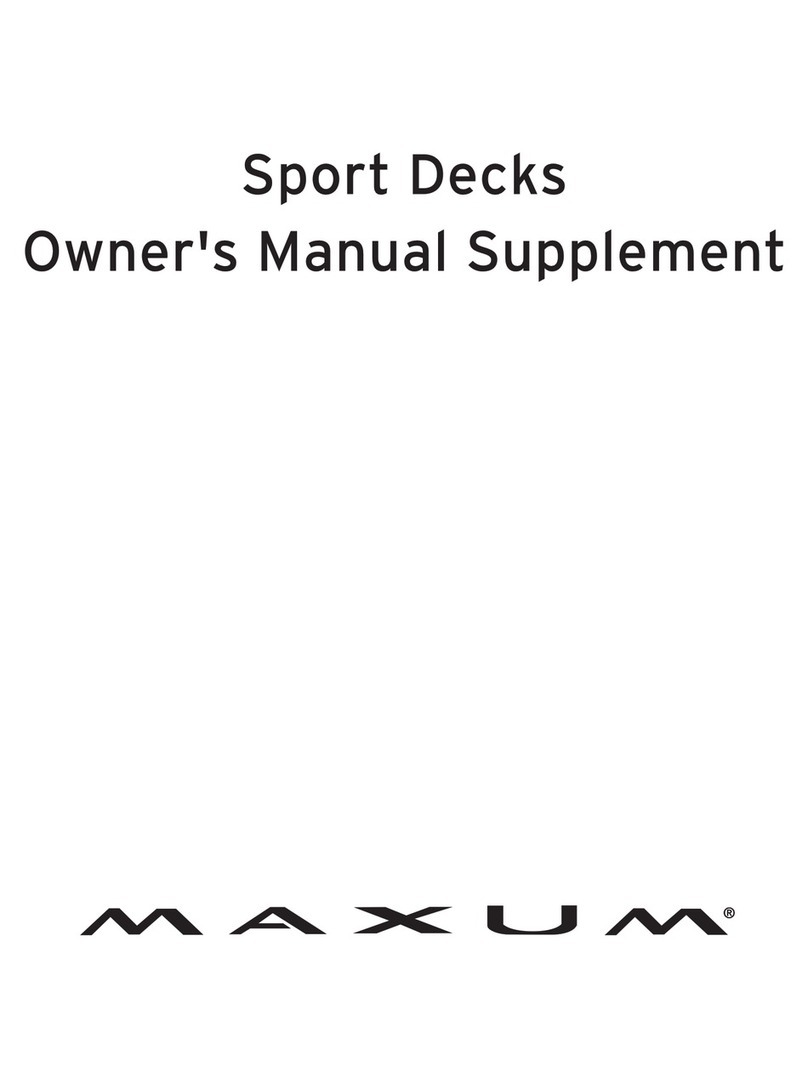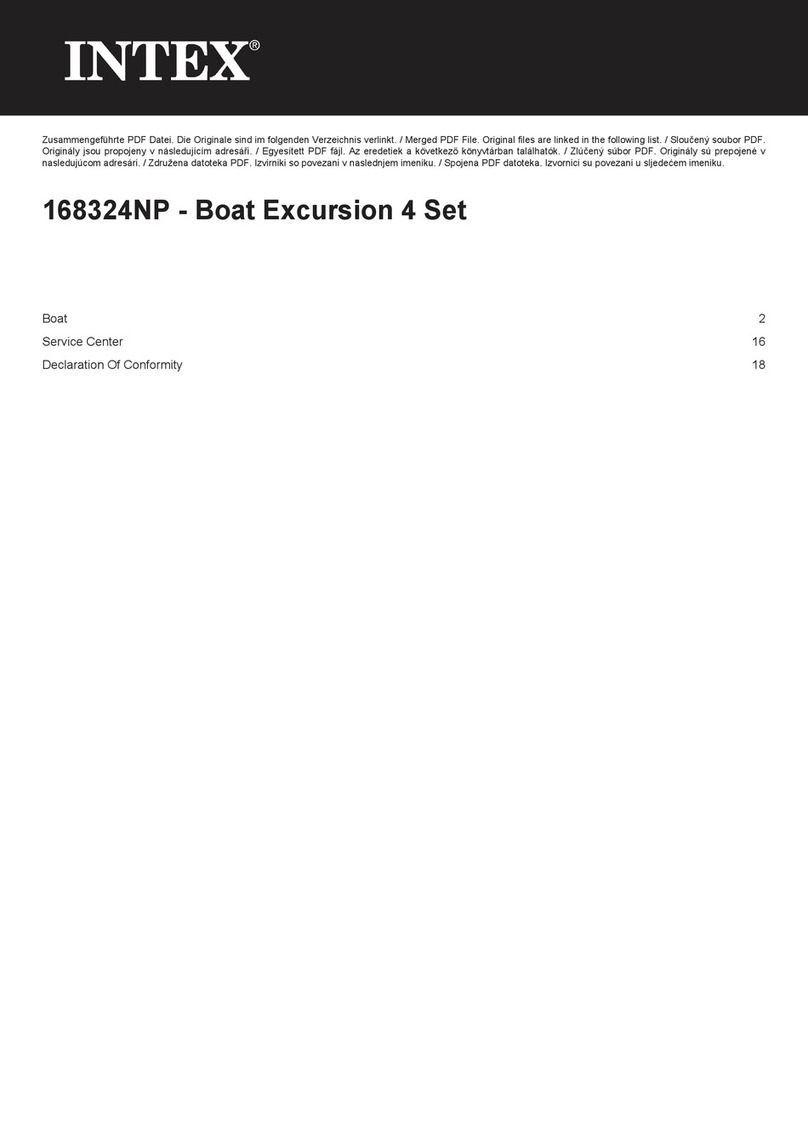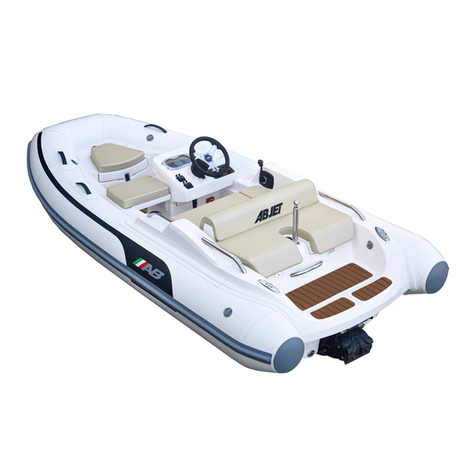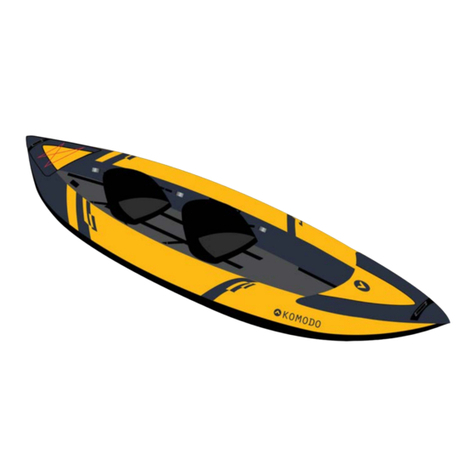Skeeter DEEP-V User manual

DEEP-V OWNER’S MANUAL

INTRODUCTION
RECORD IMPORTANT INFORMATION
Thank you for choosing a Skeeter boat. This Owner’s/Operator’s Manual contains information you
will need for proper operation, maintenance, and care. A thorough understanding of these simple
instructions will help you to obtain maximum enjoyment from your new boat. If you have any
questions about the operation or maintenance of your boat, please consult a Skeeter Dealer.
Because Skeeter has a policy of continuing product improvement, this product may not be exactly as
described in this Owner’s/Operator’s Manual. Specications are subject to change without notice.
This manual should be considered a permanent part of this boat and should remain with it even if the
boat is subsequently sold.
This document contains many of Yamaha’s valuable trademarks. It may also contain trademarks
belonging to other companies. Any references to other companies or their products are for
identication purposes only, and are not intended to be an endorsement.
In addition to this manual, your Skeeter boat is supplied with component manufacturer information
such as instructions, warranties, or other important information. Read these materials carefully.
Safeguard information about your Skeeter boat by recording the Hull Identication Number (HIN)
and the model of your boat, and the model and serial numbers of your outboard motor, trailer, and
accessories.
Your HIN is located on the top right side of the transom, above the water line. The U.S. Coast Guard
requires that your HIN be permanently afxed and remain on the top right side of the transom.
Hull
HIN ____________________________________________________________________________
Date Purchased __________________________________________________________________
Dealer/Phone ____________________________________________________________________
Ignition Key Number _______________________________________________________________
Registration Number/State __________________________________________________________
Outboard Motor Model # ___________________ Serial # _______________________________
Trailer Model # ___________________ Serial # _______________________________
Trolling Motor Model # ___________________ Serial # _______________________________
Accessory Model # ___________________ Serial # _______________________________
Accessory Model # ___________________ Serial # _______________________________
Accessory Model # ___________________ Serial # _______________________________
The identication numbers are important! Keep a copy of these numbers stored in a safe place off
the boat. In case of theft, damage, etc., report these numbers to the local authorities, your insurance
agent, and your Skeeter Dealer.

INTRODUCTION
BOATING CHECKLIST
BOATING TERMINOLOGY
For improved safety and enjoyment, check each of these items:
An easy way to
remember PORT side
from STARBOARD
side is “PORT” and
“LEFT” both have four
letters.

INTRODUCTION
1
Boating Safety ............................................. 1-1
Important Manual Information ....................... 1-1
Safety Information ......................................... 1-1
Limitations on Who May Operate the Boat.... 1-1
Overpowering/Overloading............................ 1-2
Boat Setup..................................................... 1-3
Design and Construction ............................... 1-4
Required Equipment...................................... 1-4
Additional Equipment Recommendations...... 1-4
Operational Requirements............................. 1-5
Cruising Limitations ....................................... 1-5
Hazard Information........................................ 1-6
Night Operation ............................................. 1-6
Water-Skiing .................................................. 1-6
To Get More Boating Safety Information ....... 1-7
Accident Reporting ........................................ 1-8
Pre-Operation Checks Checklist ................... 1-8
Check Points ................................................. 1-8
Enjoy Your Skeeter Boat Responsibly......... 1-11
2
Basic Rules of the Road ............................. 2-1
Rules of the Road.......................................... 2-1
Rules When Encountering Vessels ............... 2-2
Regulated / Limited Access Areas................. 2-5
3
Multi-Species Boats .................................... 3-1
Safety Labels................................................. 3-1
WX2060 & WX2190 Helm Layout ................. 3-3
WX2060 & WX2190 General Deck Layout.... 3-4
WX1910 Helm Layout.................................... 3-5
WX1910 General Deck Layout...................... 3-6
WX1850 Helm Layout.................................... 3-7
WX1850 General Deck Layout...................... 3-8
MX1825 & MX2025 Helm Layout .................. 3-9
MX1825 & MX2025 General Deck Layout... 3-10
Gauge and Switch Panel
(Gunwale Mount) – WX2000T..................... 3-11
WX2000T General Deck Layout.................. 3-12
Equipment ................................................... 3-13
Livewell/Baitwell System Settings ............... 3-18
4
Controls / Indicators.................................... 4-1
Steering ......................................................... 4-1
Outboard Motor Trim ..................................... 4-2
Instruments.................................................... 4-3
Switches ........................................................ 4-4
Circuit Breakers / Fuses ................................ 4-5
5
Boat Systems............................................... 5-1
Electrical System........................................... 5-1
Fuel System................................................... 5-1
Bilge............................................................... 5-2
6
Operation...................................................... 6-1
Driving Your Skeeter Boat ............................. 6-2
Boat Trim ....................................................... 6-4
7
Getting Under Way ...................................... 7-1
Safety Checklist............................................. 7-1
Safety Equipment .......................................... 7-1
Boarding ........................................................ 7-1
8
Running........................................................ 8-1
Maneuvering Techniques............................... 8-1
Anchoring ...................................................... 8-2
Performance Boating..................................... 8-2
Propellers ...................................................... 8-3
Post-Operation Checks ................................. 8-3
Trailering........................................................ 8-4
9
Care / Maintenance...................................... 9-1
Repairs and Modications ............................. 9-1
Electrical........................................................ 9-1
Corrosion Protection...................................... 9-3
General Maintenance .................................... 9-4
Fuel System................................................... 9-5
Motor Mounts................................................. 9-6
Steering System ............................................ 9-8
Service / Maintenance Log............................ 9-9

10
Troubleshooting ........................................ 10-1
Trouble Check Chart ................................... 10-1
11
Storage ....................................................... 11-1
Preparing Boat for Storage.......................... 11-1
Lifting........................................................... 11-2
Trailering...................................................... 11-3
12
Glossary of Terms ..................................... 12-1
Float Plan .....................................................F-1
Warranty ......................................................W-1
INTRODUCTION

1-1Table Of Contents www.SkeeterBoats.com
BOATING SAFETY
IMPORTANT MANUAL INFORMATION
SAFETY INFORMATION
LIMITATIONS ON WHO MAY OPERATE THE BOAT
WARNING CAUTION
In this manual, information of particular importance is distinguished in the following ways:
The Safety Alert Symbol means
ATTENTION! BECOME ALERT!
YOUR SAFETY IS INVOLVED!
The safe use and operation of this boat is dependent upon the use of proper operating techniques,
as well as upon the common sense, good judgment, and expertise of the operator. Every operator
should know the following requirements before operating the boat.
• Before operating the boat, read this Skeeter Owner’s/Operator’s Manual, the Owner’s/Operator’s
Manual for the outboard motor, the literature for all other equipment supplied with your boat or
trailer, and all warning and caution labels on the boat, motor, and trailer. These materials should
give you an understanding of the boat and its operation.
• Never allow anyone to operate this boat until they too have read the Owner’s/Operator’s Manual
and all warning and caution labels.
• Skeeter recommends a minimum operator age of 16 years old.
• Adults must supervise use by minors.
• Know the operator age and training requirements for your state. A boating safety course is
recommended and may be required in your state. You can nd local rules by contacting the United
States Coast Guard (USCG), the National Association of State Boating Law Administrators, or your
local Power Squadron.
• This Skeeter boat has maximum capacities for number of passengers and weight on board. Never
exceed these maximum load limits. Weight distribution affects performance. Keep weight in the
boat low and evenly distributed from side-to-side and front-to-back. Remove any unnecessary
cargo and store it on shore.
NOTE: A NOTE provides key information to make procedures easier or clearer.
Failure to follow WARNING instructions could
result in severe injury or death to the boat operator
or passengers, a bystander, or a person inspecting
or repairing the boat.
A CAUTION indicates special
precautions that must be taken
to avoid damage to the boat.

1-2Table Of Contents www.SkeeterBoats.com
BOATING SAFETY
OVERPOWERING/OVERLOADING
DO NOT overpower or overload your boat. Your boat is equipped with a required capacity plate
indicating the maximum acceptable power and load as determined by the manufacturer following
certain Federal guidelines. In doubt, contact your Skeeter Dealer.
Using an outboard motor that exceeds the maximum horsepower limit of a boat can:
• Cause loss of boat control.
• Place too much weight at the transom, altering the design otation characteristics of the boat.
• Cause structural damage.
Overpowering a boat can result in serious injury, death, or boat damage.
Typical Capacity Plate
Figure 1-1
WARNING
DO NOT overpower or overload your boat.

1-3Table Of Contents www.SkeeterBoats.com
BOATING SAFETY
BOAT SETUP
Your Skeeter boat is shipped from Skeeter with almost all the necessities to operate your boat. Not
all boats will be equipped as others, since you have the option on how to accessorize and equip your
boat.
The installation of your outboard motor is already done by Skeeter. The installation height may have
to be adjusted to optimize and maximize its performance. (The installation height is the distance from
the bottom of the cavitation plate to the top of the straight edge.) The installation height should never
be adjusted by someone who is not qualied to establish the correct installation height. The installed
height is based on an average, since Skeeter cannot predetermine your boat’s loads or uses. The
addition of add-ons or accessories which can inhibit performance and safety should never be added
as a means of trying to increase performance. If you believe you are experiencing poor performance,
contact your Skeeter Dealer.
A jack plate is sometimes used on boats to adjust engine installation height. Do not use a jack
plate on your Skeeter boat unless it is specically designed for one, and then only use the Skeeter-
recommended jack plate. Other jack plate installations are considered misuse and are not covered by
warranty.
For jack plate operation, see the operation manual that came with your boat.
Engine Stop Switch and Cord Lanyard
Your Skeeter boat is equipped with an engine stop switch and cord lanyard. Skeeter strongly
recommends that the cord lanyard be secured to the operator and the lock plate attached to the
engine stop switch prior to starting the engine and anytime the engine is operating.
This device is designed to turn off the engine whenever the operator moves far enough away from
the helm to activate the switch. It is strongly recommended that the operator use the cord lanyard.
WARNING
WARNING
Do not attempt to alter your Skeeter boat to increase performance. Modications could
make your boat unsafe to use, increasing the risk of severe injury or death.
• Attach the engine stop switch cord lanyard to a secure place on your clothing, arm, or
leg while operating.
• Avoid accidentally pulling the cord lanyard power means loss of most steering control.
Also, without engine power, the boat could slow rapidly. This could cause people and
objects in the boat to be thrown forward.
• DO NOT attach the cord lanyard to clothing that could tear loose. DO NOT route the
cord lanyard where it could become entangled, preventing it from functioning.

1-4Table Of Contents www.SkeeterBoats.com
BOATING SAFETY
DESIGN AND CONSTRUCTION
REQUIRED EQUIPMENT
ADDITIONAL EQUIPMENT RECOMMENDATIONS
The U.S. Coast Guard (USCG) has regulations which describe minimum standards of safety. All
Skeeter boats have been certied by the National Marine Manufacturers Association (NMMA) to meet
or exceed all USCG requirements and American Boat & Yacht Council (ABYC) standards such as:
• Flotation
• Capacity
• Fuel System
• Ventilation
• Wiring
• Sound signaling device and navigation lights
The following USCG safety equipment must be provided by the owner and carried onboard.
• Life Jackets: One wearable life jacket for each person on board. Life jackets must be
USCGapproved and in good and serviceable condition (see OPERATIONAL REQUIREMENTS on
page 1-8 for more information).
• Throwable Device: At least one USCG-approved throwable otation device (Type IV).
• Fire Extinguisher: At least one Marine Type USCG hand-held, portable re extinguisher (Type B-I or
B-II).
• Visual Distress Signals: It is recommended that a USCG-approved pyrotechnic device be stored on
your boat. A mirror or distress ag can also be used as an emergency signal.
Your Skeeter Dealer will be happy to assist you with these requirements.
The following equipment can help make your boating experience safer and more enjoyable:
• Cell phone and charger
• Mooring fenders and lines for docking
• Anchor with suitable line (a “Danforth” type anchor and line that is at least 6 times the depth of the
water where you will drop anchor are recommended)
• Manual-type bilge pump
• First aid kit
• Waterproof ashlight with extra batteries
• Tool kit with assorted screwdrivers, pliers, wrenches (including metric sizes), and electrical tape
• Oar or paddle (look for one with a boat hook on the other end)
• Spare parts, such as an extra set of spark plugs and fuses
• Navigation charts or mobile app for the waters where you will be boating
• Towrope
• Portable GPS or marine navigation app

1-5Table Of Contents www.SkeeterBoats.com
BOATING SAFETY
OPERATIONAL REQUIREMENTS
CRUISING LIMITATIONS
• The operator and all passengers should wear a USCG-approved life jacket. USCG regulations
require that the proper number and type of life jackets be aboard the boat for each adult passenger
and worn by each child under 13 years old. However, some foreseeable accidents could happen
so quickly on any boat that there would not be time to put on a life jacket. Therefore, Skeeter
recommends life jacket use at all times while the boat is in operation.
• Eye protection is recommended to keep wind, water, and glare from the sun out of your eyes while
you operate your Skeeter boat. Restraining straps for eyewear are made which are designed to oat
should your eyewear fall into the water.
• Footwear and gloves are recommended.
• NEVER operate the boat after consuming alcohol or taking drugs.
• For reasons of safety and proper care of your Skeeter boat, always perform the pre-operation
checks listed on page 1-13 before operating.
• Passengers must always sit in a designated seating area, place feet on the deck, and hold on to the
hand grips when the boat is in motion.
• Always consult your doctor on whether it is safe for you to ride in this boat if you are pregnant or in
poor health.
• Do not attempt to modify this Skeeter boat! Modications to your boat may reduce safety and
reliability, and render the boat unsafe or illegal to use.
• Attach the engine stop cord (lanyard) to the operator’s life jacket and keep it free from steering
wheel or other controls so that the engine stops if the operator accidentally leaves the helm. Failure
to attach the engine stop cord could result in a runaway boat if the operator is ejected.
• After operation, remove the engine stop cord and the keys to avoid accidental starting or
unauthorized use by children or others.
• Scan constantly for people, objects, and other watercraft. Be alert for conditions that limit your
visibility or block your vision of others.
• Operate defensively at safe speeds and keep a safe distance from people, objects, and other
watercraft.
• Do not follow directly behind other boats.
• Do not go near others to spray or splash them with water.
• Avoid sharp turns or other maneuvers that make it hard for others to avoid you or understand where
you are going.
• Avoid areas with submerged objects or shallow water.
• Operate within your limits and avoid aggressive maneuvers to reduce the risk of loss of control,
ejection, and collision.
• This is a high-performance boat – not a toy. Sharp turns or jumping waves or wakes can increase
the risk of back/spinal injury (paralysis), facial injuries, and broken legs, ankles, and other bones. Do
not jump waves or wakes.
• Do not operate the boat in rough water, bad weather, or when visibility is poor; this may lead to an
accident causing injury or death. Be alert to the possibility of bad weather. Take note of weather
forecasts and the prevailing weather conditions before setting out in your boat.

1-6Table Of Contents www.SkeeterBoats.com
BOATING SAFETY
CRUISING LIMITATIONS (Cont.)
HAZARD INFORMATION
WATER-SKIING
NIGHT OPERATION
• Leave a “oat plan” with a responsible person on shore. Tell where you plan to go and when you
plan to arrive, and provide a description of your boat. Advise this person if your plans change and
also when you arrive to prevent false alarms. A sample oat plan is included in this manual.
• Never start the engine or let it run for any length of time in an enclosed area. Exhaust fumes contain
carbon monoxide, a colorless, odorless gas that may cause death within a short time. Always
operate the boat in an open area.
• Do not use the reverse function to slow down or stop the boat as it could cause you to lose control,
be ejected, or impact the steering wheel or other parts of the boat. This could increase the risk of
serious injury. It could also damage the shift mechanism.
• Reverse can be used to slow down or stop during slow-speed maneuvering, such as when docking.
Once the engine is idling, shift to reverse and gradually increase engine speed. Make sure that
there are no obstacles or people behind you before shifting into reverse.
• Stop the engine and remove the clip from the engine stop switch before removing any debris or
weeds which may have collected around the propeller.
• Some Skeeter boats are equipped to tow a waterskier, using the tow cleat or ski pylon provided.
• It is the boat operator’s responsibility to be alert to the safety of the water-skier and others. Know
and follow all state and local water-skiing regulations in effect for the waters in which you will be
operating.
• The following are some important considerations for minimizing risks while water-skiing.
• The skier should wear an approved PFD, preferably a brightly colored one so boat operators can
see the skier.
• The skier should wear protective clothing. Severe internal injuries can occur if water is forced into
body cavities as a result of falling into the water or while reboarding. The skier should wear a wetsuit
bottom or clothing that provides equivalent protection. Such clothing includes thick, tightly woven,
sturdy, and snug-tting apparel such as denim, but does not include spandex or similar fabrics like
those used in bicycle shorts.
• A second person should be on board in a rearfacing seat as a spotter to watch the skier; in most
states it is required by law. Let the skier direct the operator’s control of speed and direction with
hand signals.
When using your boat before dawn or after dusk, you must have both bow and stern lights operating.
When at anchor in the dark, the stern light must be lit. See Section 6 for more information.

1-7Table Of Contents www.SkeeterBoats.com
BOATING SAFETY
WATER-SKIING (Cont.)
TO GET MORE BOATING SAFETY INFORMATION
• When preparing to pull a skier, operate the boat at the slowest possible speed until the boat is well
away from the skier and slack in the towrope is taken up. Make sure that the rope is not looped
around anything.
• After checking that the skier is ready and that there is no trafc or other obstacles, apply enough
throttle to raise the skier.
• Make smooth, wide turns. The boat is capable of very sharp turns, which could exceed the abilities
of the skier. Keep the skier at least 50 meters (150 feet), about twice the distance of a standard
towrope, away from any potential hazard.
• Be alert to the hazard of the towrope handle snapping back at the boat when the skier falls or is
unable to get up on the skis.
Be informed about boating safety. Additional publications and information can be obtained from many
organizations, including the following.
United States Coast Guard
Boating Safety Division
2100 2nd Street, Stop 7581
Washington, D.C. 25093-1062
Boating Safety Websites
U.S. Coast Guard - www.uscgboating.org
U.S. Coast Guard Auxiliary - www.cgaux.org
National Association of State Boating Law Administrators - www.nasbla.org
National Safe Boating Council - www.safeboatingcouncil.org
National Water Safety Congress - www.watersafetycongress.org
Boat Education and Training
The Online Boating Safety Course is available at http://www.boatus.org. Upon successful completion
of 80% or better, the user can request a certicate of completion by mail or can download one
immediately. The Online Boating Safety Course, provided by the Boat/US Foundation, is approved by
the National Association of State Boating Law Administrators (NASBLA) and recognized by the United
States Coast Guard. This course meets the education requirement for those states that recognize
non-proctored, NASBLA-approved courses.

1-8Table Of Contents www.SkeeterBoats.com
BOATING SAFETY
ACCIDENT REPORTING
CHECK POINTS
PRE-OPERATION CHECKS CHECKLIST
Boat operators are required by law to le a Boating Accident Report with their state boating law
enforcement agency if their boat is involved in any of the following accidents:
1. There is loss of life or probable loss of life.
2. There is personal injury which requires medical attention beyond rst aid.
3. There is damage to boats or other property which exceeds $500.00.
4. There is complete loss of a boat.
Contact local law enforcement personnel if a report is necessary.
Perform the following in addition to the pre-operation check points provided in your outboard motor
owner’s manual.
Steering
Make sure the wheel is not loose. There should not be any free play, either in-and-out or in rotation.
With the engine trimmed for normal operation, turn the steering wheel full-right and full-left to make
sure operation is smooth and unrestricted throughout the whole range.
Keep the steering cable end clear of obstructions such as wiring, control cables, fuel lines, tow lines,
and mooring lines.
Keep moving parts clean and lubricated.
Inspect the steering cable ends/hydraulic hoses for kinks, damage, or corrosion.
Before operating this boat, perform the following checks:
If any item in the Pre-Operation Check is not working properly, have it inspected and repaired before
operating your boat. Otherwise an accident could occur.
NOTE: Pre-operation checks should be made each time the boat is used. This procedure
can be accomplished thoroughly in a short time. The added safety and reliability the
checks assure is worth the time involved.

1-9Table Of Contents www.SkeeterBoats.com
BOATING SAFETY
CHECK POINTS (Cont.)
Throttle and Shifting
Operate the throttle lever several times to make sure there is no hesitation in its travel. Operation
should be smooth over the complete range of motion. See your outboard owner’s manual for more
information.
Fire Extinguisher
Make sure the re extinguisher is aboard, full, and in serviceable condition. Fire extinguishers are
dated for periodic servicing. See the instructions supplied by the re extinguisher manufacturer to
determine proper indication of condition.
Hull
Before launching, check the hull of your boat for damage.
Drainage System
Bilge Pump: Your Skeeter boat is equipped with a drainage system that channels water entering the
boat from the storage compartments to the bilge under the engine compartment. When the pump is
on, most of the water in the bilge will drain through the outlet. For manual bilge pump systems, the
pump will operate when the bilge pump switch is turned on. If your boat is equipped with an automatic
bilge pump, the pump will sense when there is excessive water in the bilge and will automatically turn
on.
On boats equipped with an automatic bilge system, the bilge switch can be used to override the
automatic system and to test the bilge pump. When the switch is activated, listen to hear if the
pump is operating. It may not pump water unless water is present. Do not operate the bilge pump
continuously when it is dry.
Inspect the bilge area frequently for evidence of excessive water. Continuous operation of the
bilge pump can indicate excessive water entering the bilge. Debris can also prevent the pump from
operating or make it operate continuously. Test the bilge pump at regular intervals. Make sure no
debris is blocking the bilge pump oat.
Drain Plug: A drain plug is located at the center of the stern to allow more complete draining when
the boat is removed from the water.
WARNING
Always carry a re extinguisher on board.

1-10Table Of Contents www.SkeeterBoats.com
BOATING SAFETY
CHECK POINTS (Cont.)
Lights
Check for proper operation of the bow, stern, and instrument lights by pressing the switch on the
control panel. If the stern light is not installed, remove it from the storage area, lift the socket cover,
and install it into the socket to check operation.
Horn
Press the horn switch to be sure the horn operates.
Fuel and Oil
Follow your outboard motor owner’s manual for information about the proper fuel and oil for your
motor.
Engine Stop Switch
First, place the boat in the water to provide adequate engine cooling. Start the engine, and then
remove the engine stop switch clip, and verify that the engine stops. See your outboard motor
owner’s manual for more information.
Fuel/Oil Spillage
The spilling of fuel or oil into our waterways contaminates the environment and is dangerous to
wildlife. Do not discharge or dispose of fuel, oil, or other chemicals into the water; it is prohibited and
you can be ned. These are two common, accidental types of discharge:
• Overlling the fuel tanks
• Pumping contaminated bilge water
Discharge / Disposal of Waste
Waste means all forms of garbage, plastics, recyclables, food, wood, detergents, sewage, and even
sh parts in certain waters – in short, nearly everything. We recommend you bring back everything
you take out with you for proper disposal ashore. Use an approved pump-out facility at your marina.
Many areas prohibit the discharge of sewage overboard or even an operable overboard waste
discharge.
Excessive Noise
Noise means engine noise, radio noise, or even voices. Many bodies of water have adopted noise
limits. Music and loud conversation can carry a considerable distance on water, especially at night.
Be sure to follow regulations and be courteous.
WARNING
Fumes from rags can collect in the bilge and be extremely hazardous. Do not store rags
used to wipe up fuel or solvent spills in the boat. Dispose of rags properly ashore.

1-11Table Of Contents www.SkeeterBoats.com
BOATING SAFETY
CHECK POINTS (Cont.)
Wake / Wash
Be alert for NO WAKE zones. Prior to entering a no wake zone, come off plane to the slowest
steerable speed. Use caution when operating around smaller crafts, in channels and marinas, and in
congested areas.
WARNING
You are responsible for injury and damage caused by your wake/wash.
ENJOY YOUR SKEETER BOAT RESPONSIBLY
You share the areas you enjoy when operating your boat with others and with nature. So your
enjoyment includes a responsibility to treat these other people, and the lands, waters, and wildlife
with respect and courtesy. Whenever and wherever you are boating, think of yourself as the guest
of those around you. Remember, for example, that the sound of your boat may be music to you, but
it could be just noise to others. And the exciting splash of your wake can make waves others won’t
enjoy. Avoid riding close to shoreline homes and waterfowl nesting areas or other wildlife areas, and
keep a respectful distance from shermen, other boats, swimmers, and populated beaches. When
travel in areas like these is unavoidable, operate slowly. Remember that pollution can be harmful to
the environment. Do not refuel or add oil where a spill could cause damage to nature. And keep your
surroundings pleasant for the people and wildlife that share the waterways: don’t litter!
When you go boating responsibly, with respect and courtesy for others, you help ensure that our
waterways stay open for the enjoyment of a variety of recreational opportunities.
Foreign Species
If you trailer your boat from lake to lake, you may unknowingly introduce a foreign aquatic species
from one lake to the next. Thoroughly clean the boat below the water line, remove all weeds and
algae, and drain the bilge before launching the boat in a new body of water.

2-1Table Of Contents www.SkeeterBoats.com
BASIC RULES OF THE ROAD
RULES OF THE ROAD
Operation of your boat must be in accordance with the rules and regulations governing the waterway
on which it is used. Just as there are rules that apply when you are driving on streets and highways,
there are waterway rules that apply when you are operating your boat. These rules are used
internationally, and are also enforced by the United States Coast Guard and local agencies. You
should be aware of these rules, and follow them whenever you encounter another vessel on the
water.
Several sets of rules prevail according to geographic location, but are all basically the same as the
International Rules of the Road. The rules presented here in this Owner’s/Operator’s Manual are
condensed, and have been provided for your convenience only. Consult your local U.S. Coast Guard
Auxiliary or Department of Motor Vehicles for a complete set of rules governing the waters in which
you will be operating your boat.
Steering and Sailing Rules
Whenever two vessels on the water meet one another, one vessel has the right-of-way; it is called the
“standon” vessel. The vessel that does not have the right-ofway is called the “give-way” or “burdened”
vessel. These rules determine which vessel has the right-ofway, and what each vessel should do.
Stand-On Vessel
The vessel with the right-of-way has the duty to continue its course and speed, except to avoid an
immediate collision. When you maintain your direction and speed, the other vessel will be able to
determine how best to avoid you.
Give-Way Vessel
The vessel which does not have the right-of-way has the duty to take positive and timely action to
stay out of the way of the stand-on vessel. Normally, you should not cross in front of the vessel with
the right-ofway. You should slow down or change directions briey and pass behind the other vessel.
You should always move in such a way that the operator of the other vessel can see what you are
doing.
The General Prudential Rule regarding the right-of way is that if a collision appears unavoidable,
neither boat has the right-of-way. Both boats must avoid the collision. In other words, follow the
standard rules except when a collision will occur unless both vessels try to avoid each other. If that is
the case, both vessels become give-way vessels.

2-2Table Of Contents www.SkeeterBoats.com
BASIC RULES OF THE ROAD
RULES WHEN ENCOUNTERING VESSELS
There are three main situations that you may encounter with other vessels which could lead to a
collision unless the Steering Rules are followed:
• Meeting: you are approaching another vessel head-on
• Crossing: you are traveling across another vessel’s path
• Overtaking: you are passing or being passed by another vessel
Meeting
If you are meeting another power vessel head-on, and are close enough to run the risk of collision,
neither of you has the right-of-way! Both of you should alter course to avoid an accident. You should
keep the other vessel on your port (left) side. This rule does not apply if both of you will clear one
another if you continue on your set course and speed.
Figure 2-1

2-3Table Of Contents www.SkeeterBoats.com
BASIC RULES OF THE ROAD
RULES WHEN ENCOUNTERING VESSELS (Cont.)
Crossing
In crossing situations, the boat to the right from the 12 o’clock to the 4 o’clock position has the
right-of-way and must hold course and speed. The boat without right-of-way must yield and pass to
the stern of the privileged boat. Boats going up and down a river have the right-of-way over boats
crossing the river.
Figure 2-2

2-4Table Of Contents www.SkeeterBoats.com
BASIC RULES OF THE ROAD
RULES WHEN ENCOUNTERING VESSELS (Cont.)
Overtaking
If you are passing another vessel, you are the giveway vessel. This means that the other vessel is
expected to maintain its course and speed. You must stay out of its way until you are clear of it.
Likewise, if another vessel is passing you, you should maintain your speed and direction so that the
other vessel can steer itself around you.
Other Special Situations
There are three other rules you should be aware of when operating your boat around other vessels.
Narrow Channels and Bends
When navigating in narrow channels, you should keep to the right when it is safe and practical to do
so. If the operator of a power-driven vessel is preparing to go around a bend that may obstruct the
view of other water vessels, the operator should sound a prolonged blast of 4-6 seconds on the horn.
If another vessel is around the bend, it too should sound the horn. Even if no reply is heard, however,
the vessel should still proceed around the bend with caution.
Fishing Vessel Right-of-Way
All vessels shing with nets, lines, or trawls are considered to be “shing vessels” under the
International Rules. Vessels with trolling lines are not considered shing vessels. Fishing vessels
have the right-of-way regardless of position. Fishing vessels cannot, however, impede the passage of
other vessels in narrow channels.
Figure 2-3
Table of contents
Other Skeeter Boat manuals




